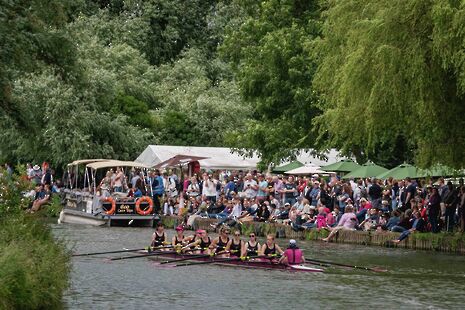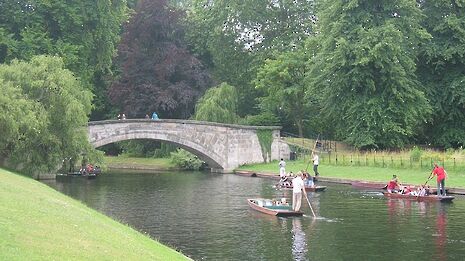May Bumps: What’s it all about?
All you need to know about what’s happening in the biggest inter-collegiate sporting contest

It is a well known fact that boaties, myself included, talk a lot about rowing. But you might have noticed that their favourite conversation topic has gone into overdrive in the last few days, and that’s because Bumps is here once more! For those of you who never got used to the early mornings (or didn’t need any help making friends), here’s the quick run-down to the crown jewel of college sport:
What’s it all about?
The May Bumps is the largest intra-university sporting competition in the world - this year will see almost 1,400 competitors racing over four days. The finishing order makes up the starting order for the next year, and so Bumps is really one continuous race that has been running since 1887.
The River Cam isn’t wide enough to race boats in the usual side-by-side regatta format, so bumps racing has been going on for nearly 200 years between the college boat clubs.
18 boats will line up at the start of the course, at Baitsbite Lock about five kilometres from the centre of Cambridge, and race back towards town. Boats start one and a half boat lengths away from each other, and the objective is to crash into the boat in front.
Bumps
Any contact between one boat and another, the boat itself, the oars, or even the rowers themselves, counts as a bump. Both crews then have to clear the river as quickly as possible to allow crews behind to pass. Once a crew has bumped, or been bumped, their race is over and they will swap positions in the order for the next day’s race.
If a pair of crews in front have bumped out, a crew can instead chase the boat three in front. If they catch them, this is called an overbump and the crew will jump ahead of all three boats in one go. In even rarer cases, boats can double, triple, or even quadruple overbump.
A crew that doesn’t bump has to complete the full course, nearly three kilometres, and is said to have rowed over. They will start the next day’s race in the same position.
Sandwiches
There are nine divisions in the May Bumps (five for the men, four for the women), and they are run in reverse order, so the top divisions race at the end of the day. This means that crews that manage to bump their way to the top of a division, or row over at the head, get the opportunity to race in the next division to bump into a higher division. This crew is called the sandwich boat.
Blades (and Spoons)
Every crew races four times, which means that they can go up a maximum of four places in a single set of bumps (barring an extra bump as the sandwich boat, or scoring an overbump).
A crew that bumps on all four days wins their blade, and earn the right to an oar painted in their college colours, listing the crew members and their vanquished opponents. Variants on this are superblades (bumping in every race, and going up more than four places) and technical blades (going up four or more places, but not bumping at every opportunity).
Likewise, the unlucky crews that find themselves bumping down every day earn their “spoons”. Particularly cruel boat clubs are known to make spooning crews eat their meal only using spoons at the celebratory Boat Club Dinners that take place on Saturday evening at the end of racing.
Carnage
18 boats charging down the river deliberately trying to crash into each other on a narrow river is, of course, a recipe for disaster. Crews that fail to get out of the way quickly enough, or refuses to take evasive action, can cause almighty accidents, as Wolfson and Merton colleges found out in the Summer Eights, Oxford’s equivalent of Bumps.
Each boat is accompanied by a cycling umpire, who can award technical bumps, or technical row-overs, to crews that have been obstructed by carnage on the river. In extreme circumstances, the division will be stopped and rerowed between affected crews.
In the bottom divisions, a lack of entries this year has meant that there was no qualifying race on the men’s side, and only one women’s crew failed to make the cut (sorry Clare W5!). As a result, the bottom crews on the river have not had to prove themselves at any point in the term, meaning that chaos is likely at the bottom of the M5 and W4 divisions.
Who’s the winner?
On Saturday evening, the two crews who top the M1 and W1 divisions will be named the ‘Head of the River’. At the moment, Lady Margaret (the Boat Club of St John’s College) hold the men’s Headship, successfully defending the position they dramatically won in 2016 last year, with Clare, Caius, and Pembroke chasing them this year.
Jesus won the women’s Headship last year, bumping Downing and Caius on their way to the top. This year, they’ll be hoping to hold off Emmanuel, Caius, and Newnham to hold on to the top spot.
The secondary prize is the Pegasus Cup, awarded to the club that performs the best overall. Each college is awarded a score which accounts for the number of positions gained, adjusting for the number of boats racing.
Who’s going to win this year?
Bumps is an absolute nightmare to predict – a slow boat can be saved from being bumped if they have an even slower one in front – so it’s anyone’s guess what the charts will look like on Sunday. That said, BumpIt, the Bumps prediction game run by First and Third (Trinity’s Boat Club) produces an aggregated chart suggesting how the week might play out.
The armchair pundits view is that Lady Margaret will hold the men’s headship, with 72% backing the club to row over at the top on all four days. Opinion is more divided over the fate of the women’s headship, with roughly equal numbers backing Jesus, Emmanuel, and Newnham to prevail.
Where can I watch?
The best place for the casual rowing fan to watch Bumps is to watch the action from the Plough at Fen Ditton. From Central Cambridge, follow Cycle Route 51 to Ditton Meadows, then follow Church Street to the Plough. From there, you’ll catch the best of the action in the later divisions, and, although the bulk of the action might be over before you can see it in the early divisions, the Pimm’s and food is more than good enough to keep you entertained in the meantime.
If the promise of lower boat carnage has whet your appetite, follow the towpath from Chesterton down to the course. You’ll have to stake out a spot on the bank, as the towpath needs to be kept clear for an army of umpires, boatmen, coaches and supporters cycling through, but from Grassy Corner (just upstream of the Plough), or First Post Reach (where the race starts), you’ll get to see the frantic start to the race, and catch the early bumps.
 News / Fitz students face ‘massive invasion of privacy’ over messy rooms23 April 2024
News / Fitz students face ‘massive invasion of privacy’ over messy rooms23 April 2024 News / Climate activists smash windows of Cambridge Energy Institute22 April 2024
News / Climate activists smash windows of Cambridge Energy Institute22 April 2024 News / Copycat don caught again19 April 2024
News / Copycat don caught again19 April 2024 Comment / Gown vs town? Local investment plans must remember Cambridge is not just a university24 April 2024
Comment / Gown vs town? Local investment plans must remember Cambridge is not just a university24 April 2024 News / Cambridge University disables comments following Passover post backlash 24 April 2024
News / Cambridge University disables comments following Passover post backlash 24 April 2024






